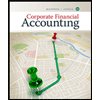
FUND.ACCT.PRIN.-CONNECT ACCESS
25th Edition
ISBN: 9781260780185
Author: Wild
Publisher: MCG
expand_more
expand_more
format_list_bulleted
Question
Chapter 6, Problem 11E
To determine
Concept Introduction:
Journal entries:
The business runs with the transactions it makes. Every transaction results in some outcome like the creation of an asset, liability, income, loss, gain, or expense. The transactions are recorded based on the resulting outcome. The debits and the credits are made based on the rules of accounting.
To prepare:
Journal entries to record the following transactions of Recycled Fashion retail store.
Expert Solution & Answer
Want to see the full answer?
Check out a sample textbook solution
Students have asked these similar questions
General accounting
General accounting question and correct solution
I need guidance with this general accounting problem using the right accounting principles.
Chapter 6 Solutions
FUND.ACCT.PRIN.-CONNECT ACCESS
Ch. 6 - Inventory ownership Homestead Crafts, a...Ch. 6 - QS 6-2 Inventory costs C2
A car dealer acquires a...Ch. 6 - Prob. 3QSCh. 6 - Prob. 4QSCh. 6 - Perpetual: Inventory costing with FIFO P1 A...Ch. 6 - Perpetual: Inventory costing with LIFO Refer to...Ch. 6 - Perpetual Inventory costing with weighted average...Ch. 6 - Periodic: Inventory costing with FIFO P3 Refer to...Ch. 6 - Periodic: Inventory costing with LIFO Refer to the...Ch. 6 - Periodic: Inventory costing with weighted average...
Ch. 6 - Perpetual: Assigning costs with FIFO Trey Monson...Ch. 6 - QS6-11
Perpetual Inventory costing with LIFO
Refer...Ch. 6 - QS 6-12
Perpetual: Inventory costing with weighted...Ch. 6 - QS6.13
Perpetual Inventory costing with specific...Ch. 6 - Periodic: Inventory costing with FIFO P3 Refer to...Ch. 6 - Periodic Inventory costing with LIFO P3 Refer to...Ch. 6 - Periodic: Inventory costing with weighted average...Ch. 6 - Periodic: Inventory costing with specific...Ch. 6 - QS 6-18 Contrasting inventory costing methods...Ch. 6 - Inventory errors A2 In taking a physical inventory...Ch. 6 - Prob. 21QSCh. 6 - Prob. 22QSCh. 6 - Prob. 23QSCh. 6 - Prob. 24QSCh. 6 - Prob. 25QSCh. 6 - Prob. 26QSCh. 6 - Exercise 6-1 Inventory ownership C1
1. At...Ch. 6 - Exercise 6-2
Inventory costs
C2
Walberg...Ch. 6 - Exercise 6-3 Perpetual Inventory costing methods...Ch. 6 - Prob. 4ECh. 6 - Prob. 5ECh. 6 - Exercise 6-5A Periodic: Inventory costing P3 Refer...Ch. 6 - Prob. 7ECh. 6 - Exercise 6-7 Perpetual Inventory costing...Ch. 6 - Exercise 6.8 Specific identification Refer to the...Ch. 6 - Prob. 10ECh. 6 - Prob. 11ECh. 6 - Prob. 12ECh. 6 - Prob. 13ECh. 6 - Prob. 14ECh. 6 - Prob. 15ECh. 6 - Prob. 16ECh. 6 - Prob. 17ECh. 6 - Prob. 18ECh. 6 - Prob. 19ECh. 6 - Prob. 20ECh. 6 - Prob. 21ECh. 6 - Problem 6-1A
Perpetual: Alternative cost...Ch. 6 - Prob. 2PSACh. 6 - Prob. 3PSACh. 6 - Prob. 4PSACh. 6 - Problem 6-5A Lower of cost or market P2 A physical...Ch. 6 - Prob. 6PSACh. 6 - Prob. 7PSACh. 6 - Prob. 8PSACh. 6 - Prob. 9PSACh. 6 - Prob. 10PSACh. 6 - Prob. 1PSBCh. 6 - Prob. 2PSBCh. 6 - Prob. 3PSBCh. 6 - Prob. 4PSBCh. 6 - Prob. 5PSBCh. 6 - Prob. 6PSBCh. 6 - Prob. 7PSBCh. 6 - Prob. 8PSBCh. 6 - Prob. 9PSBCh. 6 - Prob. 10PSBCh. 6 - Prob. 6.1SPCh. 6 - Prob. 6.2SPCh. 6 - AA 6-1 Use Apple's financial statements in...Ch. 6 - AA 6-2 Comparative figures for Apple and Google...Ch. 6 - Prob. 3AACh. 6 - Prob. 1DQCh. 6 - Where is the amount of merchandise inventory...Ch. 6 - If costs are declining, will the LIFO or FIFO...Ch. 6 - Prob. 4DQCh. 6 - Prob. 5DQCh. 6 - Prob. 6DQCh. 6 - Prob. 7DQCh. 6 - Prob. 8DQCh. 6 - BTN 6-3 Golf Challenge Corp. is a retail sports...Ch. 6 - Prob. 2BTNCh. 6 - Prob. 3BTNCh. 6 - Prob. 4BTNCh. 6 - Prob. 5BTN
Knowledge Booster
Similar questions
- i want to this question answer the genral accounting question with 100% correct solution do fastarrow_forwardI need help finding the accurate solution to this financial accounting problem with valid methods.arrow_forwardCan you explain the correct approach to solve this general accounting question?arrow_forward
arrow_back_ios
SEE MORE QUESTIONS
arrow_forward_ios
Recommended textbooks for you
 Financial And Managerial AccountingAccountingISBN:9781337902663Author:WARREN, Carl S.Publisher:Cengage Learning,
Financial And Managerial AccountingAccountingISBN:9781337902663Author:WARREN, Carl S.Publisher:Cengage Learning, Cornerstones of Financial AccountingAccountingISBN:9781337690881Author:Jay Rich, Jeff JonesPublisher:Cengage Learning
Cornerstones of Financial AccountingAccountingISBN:9781337690881Author:Jay Rich, Jeff JonesPublisher:Cengage Learning Corporate Financial AccountingAccountingISBN:9781305653535Author:Carl Warren, James M. Reeve, Jonathan DuchacPublisher:Cengage Learning
Corporate Financial AccountingAccountingISBN:9781305653535Author:Carl Warren, James M. Reeve, Jonathan DuchacPublisher:Cengage Learning Corporate Financial AccountingAccountingISBN:9781337398169Author:Carl Warren, Jeff JonesPublisher:Cengage Learning
Corporate Financial AccountingAccountingISBN:9781337398169Author:Carl Warren, Jeff JonesPublisher:Cengage Learning Financial & Managerial AccountingAccountingISBN:9781337119207Author:Carl Warren, James M. Reeve, Jonathan DuchacPublisher:Cengage LearningPrinciples of Accounting Volume 1AccountingISBN:9781947172685Author:OpenStaxPublisher:OpenStax College
Financial & Managerial AccountingAccountingISBN:9781337119207Author:Carl Warren, James M. Reeve, Jonathan DuchacPublisher:Cengage LearningPrinciples of Accounting Volume 1AccountingISBN:9781947172685Author:OpenStaxPublisher:OpenStax College

Financial And Managerial Accounting
Accounting
ISBN:9781337902663
Author:WARREN, Carl S.
Publisher:Cengage Learning,

Cornerstones of Financial Accounting
Accounting
ISBN:9781337690881
Author:Jay Rich, Jeff Jones
Publisher:Cengage Learning

Corporate Financial Accounting
Accounting
ISBN:9781305653535
Author:Carl Warren, James M. Reeve, Jonathan Duchac
Publisher:Cengage Learning

Corporate Financial Accounting
Accounting
ISBN:9781337398169
Author:Carl Warren, Jeff Jones
Publisher:Cengage Learning

Financial & Managerial Accounting
Accounting
ISBN:9781337119207
Author:Carl Warren, James M. Reeve, Jonathan Duchac
Publisher:Cengage Learning

Principles of Accounting Volume 1
Accounting
ISBN:9781947172685
Author:OpenStax
Publisher:OpenStax College